How Can Humans Selectively Breed a Vegetable to Produce a More Desirable Crop?
fourteen.3: Selective Breeding and Genetic Engineering
- Page ID
- 31649
The evolution of a new crop variety is an example of agricultural biotechnology, a range of tools that include both traditional convenance techniques and more than mod lab-based methods. Traditional methods appointment dorsum thousands of years, whereas biotechnology uses the tools of genetic engineering developed over the last few decades.
Selective Breeding (Artificial Selection)
Nearly all the fruits and vegetables found in your local marketplace would not occur naturally. In fact, they exist merely because of human intervention that began thousands of years agone. Humans created the vast majority of ingather species by using traditional convenance practices on naturally-occurring, wild plants. These practices rely upon selective breeding (artificial selection), man-facilitated reproduction of individuals with desirable traits. For example, high yield varieties were produced through selective convenance. Traditional breeding practices, although low-tech and elementary to perform, have the practical consequence of modifying an organism's genetic data, thus producing new traits.
Selective breeding is limited, however, by the life bicycle of the plant and the genetic variants that are naturally present. For example, even the fastest flowering corn variety has a generation time of 60 days (the time required for a seed to germinate, produce a mature plant, go pollinated, and ultimately produce more seeds) in perfect conditions. Each generation provides an opportunity to selectively breed individual plants and generate seeds that are slightly closer to the desired outcome (for example, producing bigger, juicier kernels). Furthermore, if no individuals happen to possess gene variants that result in bigger, juicier kernels, information technology is not possible to artificially select this trait. Finally, traditional breeding shuffles all of the genes between the ii individuals being bred, which tin can number into the tens of thousands (maize, for example, has 32,000 genes). When mixing such a large number of genes, the results can be unpredictable.
An interesting example is maize (corn). Biologists accept discovered that maize was developed from a wild plant chosen teosinte. Through traditional convenance practices, humans living thousands of years ago in what is at present Southern Mexico began selecting for desirable traits until they were able to transform the plant into what is now known equally maize (figure \(\PageIndex{a}\)). In doing so, they permanently (and unknowingly) altered its genetic instructions.
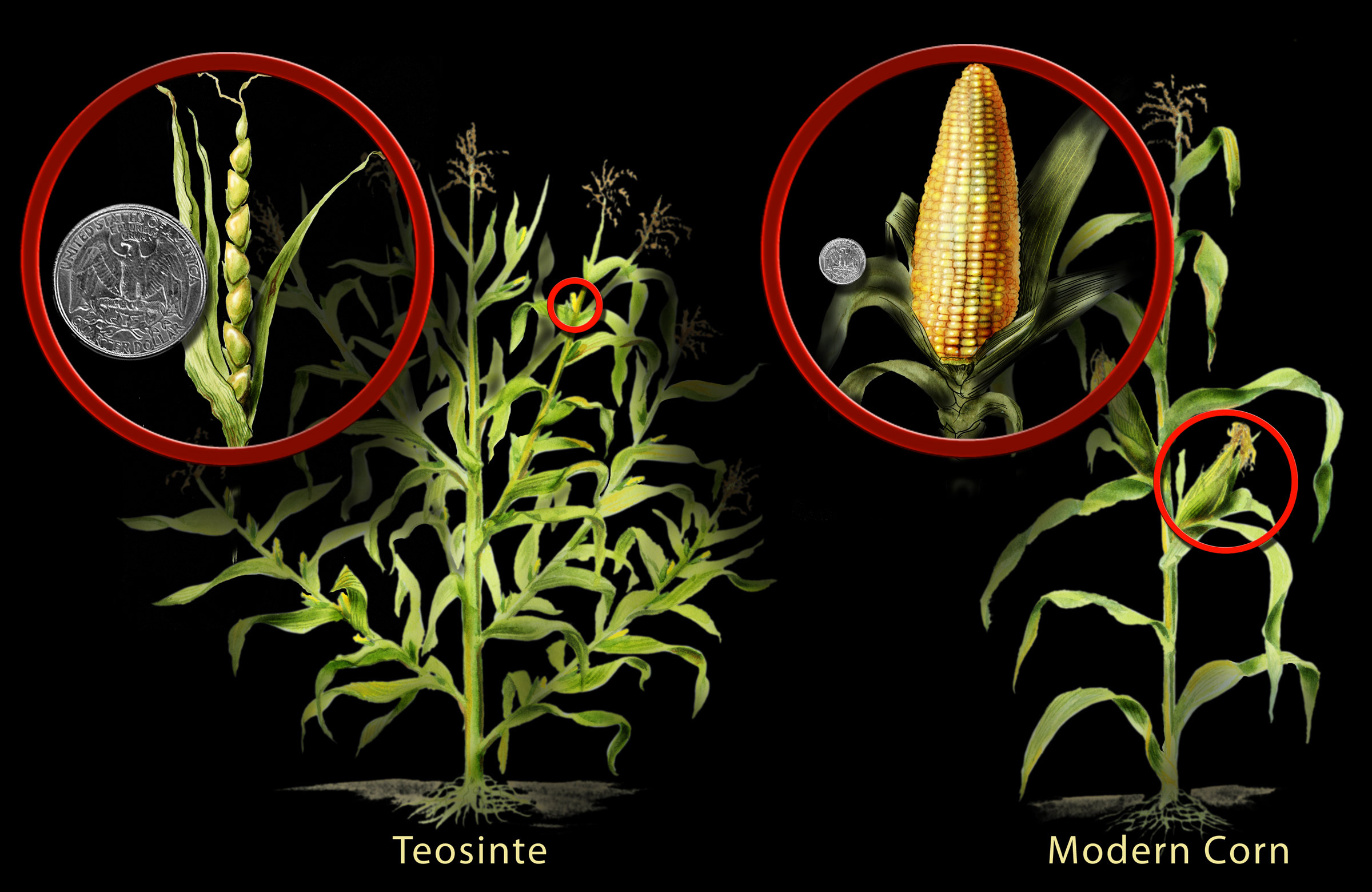
Figure \(\PageIndex{a}\): A wild grass called teosinte was genetically modified through selective breeding to produce what is now known as maize (corn). This process of transformation started thousands of years ago by indigenous people of what is at present Mexico. Paradigm by Nicolle Rager Fuller/National Scientific discipline Foundation (public domain).
This history of genetic modification is mutual to nearly all crop species. For example, cabbage, broccoli, Brussel sprouts, cauliflower, and kale were all developed from a unmarried species of wild mustard institute (figure \(\PageIndex{b}\)). Wild nightshade was the source of tomatoes, eggplant, tobacco, and potatoes, the latter developed by humans 7,000 – 10,000 years ago in South America.
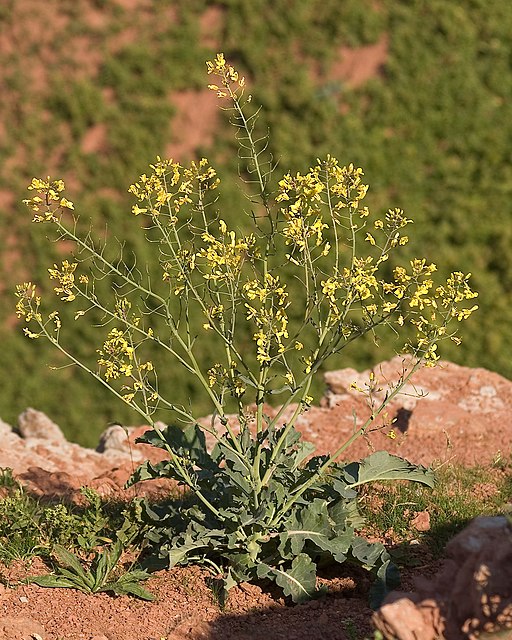
Figure \(\PageIndex{b}\):Brassica oleracea is a found in the mustard family unit and is known equally wild cabbage. From it were developed many familiar crops, such every bit cauliflower, broccoli, Brussel sprouts, and of course, cabbage. Epitome past Kulac (CC-Past-SA).
Genetic Engineering
Genetic engineering is the procedure of directly altering an organism'south DNA to produce the desired crops more rapidly than selective breeding. Because genes can be obtained from other species or fifty-fifty synthesized in the lab, scientists are non express by existing genetic variation within a crop species (or closely related species with which they can be crossed). This broadens the possible traits that can be added to crops. Modern genetic engineering is more precise than selective breeding in the sense that biologists can change only a unmarried gene. Besides, genetic engineering can introduce a gene betwixt two distantly-related species, such as inserting a bacterial gene into a found (figure \(\PageIndex{c}\)).

Figure \(\PageIndex{c}\):Both selective (traditional) breeding and modern genetic engineering produce genetic modifications. Genetic engineering allows for fewer and more precise genetic modifications. The traditional found breeding process introduces a number of genes into the plant. These genes may include the factor responsible for the desired feature, as well as genes responsible for unwanted characteristics. In traditional breeding, the donor variety Dna strand (A) and recipient variety Deoxyribonucleic acid strand (C) are combined to produce the new variety DNA strand. The donor DNA strand contains a portion of an organism'due south entire genome, including the desired gene (B). In the new variety Deoxyribonucleic acid strand, many genes are transferred with the desired gene. Genetic engineering enables the introduction into the plant of the specific gene or genes responsible for the characteristics of interest. By narrowing the introduction to one of a few identified genes, scientists can introduce the desired characteristic without too introducing genes responsible for unwanted characteristics. In genetic engineering, the desired gene (B) is copied from the donor organism's genome (A). The desired cistron from the donor organism Dna strand and the recipient diverseness Dna strand (C) are combined to produce the new variety Deoxyribonucleic acid strand. Only the desired factor is transferred to a location in the recipient genome. Modified from Michael J. Ermarth/FDA (public domain).
Genetically modified organisms(GMOs) are those that have had their DNA altered through genetic engineering. Genetically modified crops are sometimes chosen genetically engineered (GE) crops.Transgenic organisms are a type of genetically modified organism that contains genes from a different species. Because they contain unique combinations of genes and are not restricted to the laboratory, transgenic plants and other GMOs are closely monitored past regime agencies to ensure that they are fit for human consumption and practise non endanger other institute and animal life. Considering these foreign genes (transgenes) can spread to other species in the environment, specially in the pollen and seeds of plants, all-encompassing testing is required to ensure ecological stability.
How to Genetically Alter Found Cells
DNA tin be inserted into plant cells through diverse techniques. For example, agene gunpropels Dna bound to aureate particles into plant cells. (DNA is negatively charge and clings to positively charged gilded.) A more traditional approach employs the plant pathogen Agrobacterium tumefaciens (figure \(\PageIndex{d}\)). Ordinarily, this bacterium causes crown gall illness in plants past inserting a circular piece of DNA, called the Ti plasmid, into institute cells. This Dna incorporates into plant chromosomes, giving them genes to produce the gall (figure \(\PageIndex{e}\)), which provides a home for the bacterial pathogen.
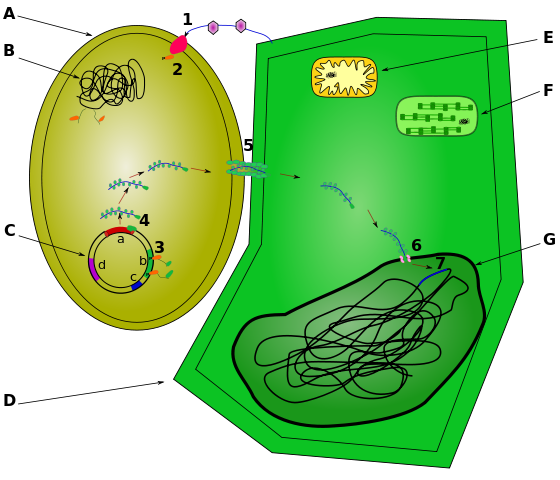
Figure \(\PageIndex{d}\): An Agrobacterium tumefaciensjail cell (A) inserts the Ti plasmid (C), which contains T-Dna (a) into a plant prison cell (D). The T-DNA somewhen enters the plant nucleus (G), where the plant DNA is stored. Image by Chandres (CC-Past-SA).
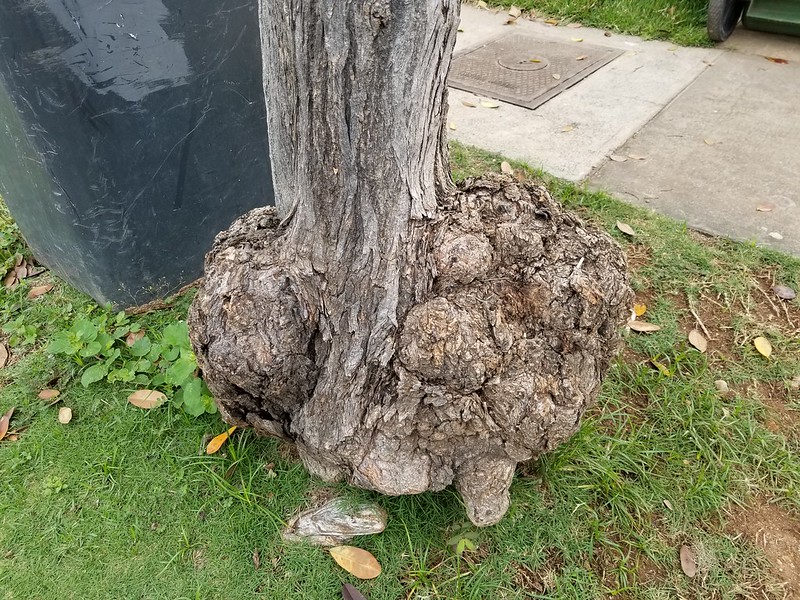
Effigy \(\PageIndex{east}\): A crown gall caused byAgrobacterium tumefaciens. This bacterium inserts DNA into plant cells, which causes them to produce the crown gall. This process tin can be adjusted by scientists to insert genes that code for desirable traits into ingather species. Image by Scott Nelson (public domain).
Scientists alters the process by whichAgrobacteriuminfects and genetically alter constitute cells to produce genetically modified plants with agriculturally beneficial traits as follows (figure \(\PageIndex{f}\)):
- T-DNA, which codes for the crown gall is removed from the Ti plasmid, and genes for desired traits are added.
- The modified plasmid is and then added back to Agrobacterium.
- Agrobacterium infects undifferentiated plant cells (stem cells that can develop into whatsoever part of the establish; figure \(\PageIndex{grand}\)).
- The modified plant cells are given hormones to produce the unabridged institute.
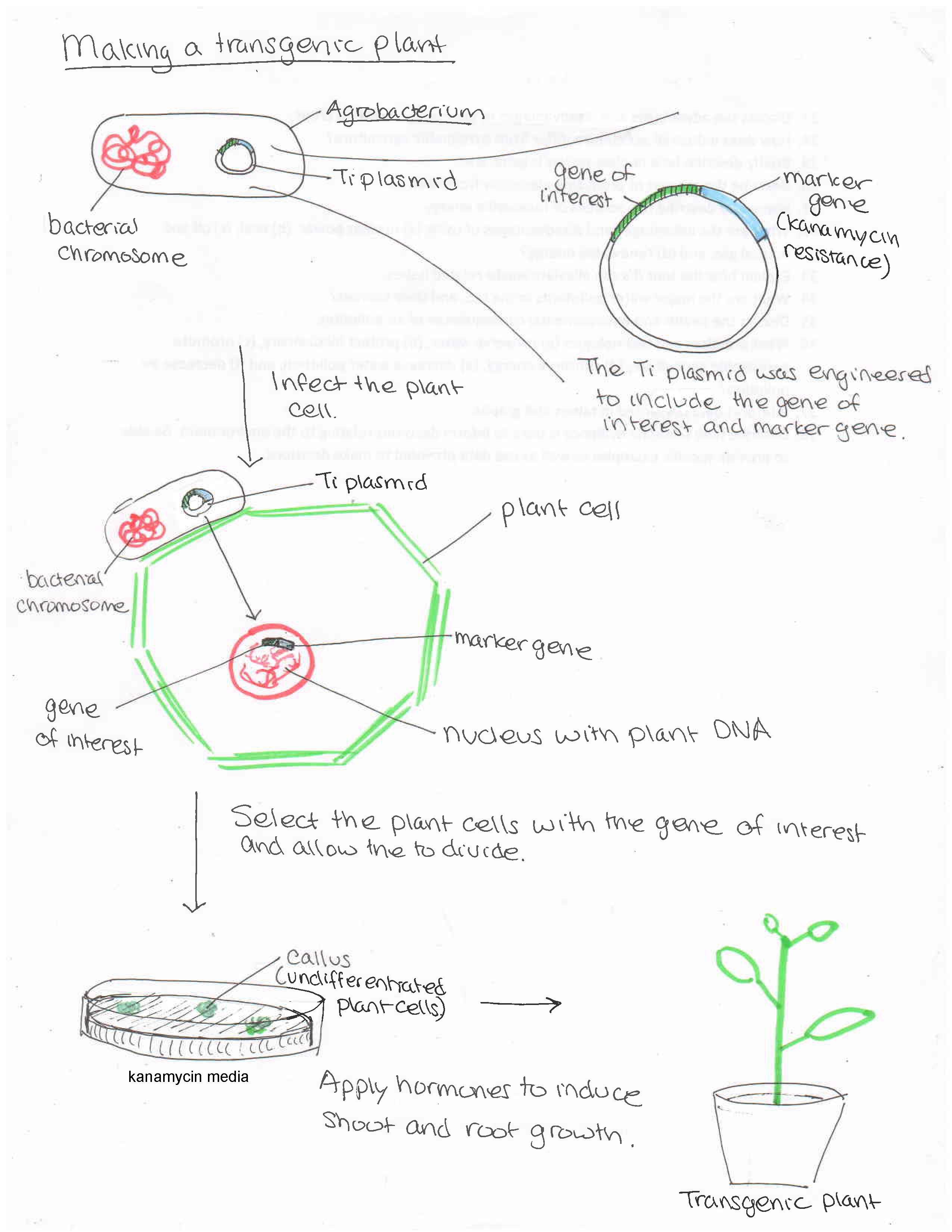
Figure \(\PageIndex{f}\): The process of producing a transgenic constitute usingAgrobacterium. The Ti plasmid was engineered to include the factor of involvement and mark cistron, which will later indicate which cells are transgenic. A rectangle represents Agrobacterium . It contains regular bacterial Deoxyribonucleic acid and the Ti plasmid, represented by a circle. The T-DNA (which provides instructors for producing a crown gall) is removed, and a transgene (factor of involvement) and maker gene are inserted instead. The gene of interest is colored dark-green, and the marking cistron (for resistance to the antibiotic kanamycin) is colored bluish. Next, institute cells are infected with Agrobacterium . The bacterial cell inserts the Ti plasmid into a polyhedral plant cell. The transgene is transferred to the plant prison cell nucleus, which contains regular constitute Dna. Next, the plant cells with the gene of interest are selected and allowed them to split up. This is done by culturing the plant cells on kanamycin media in a petri dish. Calluses, clusters of undifferentiated found cells, are produced. Finally, hormones are applied to induce shoot and root growth. An arrow points from the petri dish to a potted transgenic plant. Image by Melissa Ha (CC-BY).
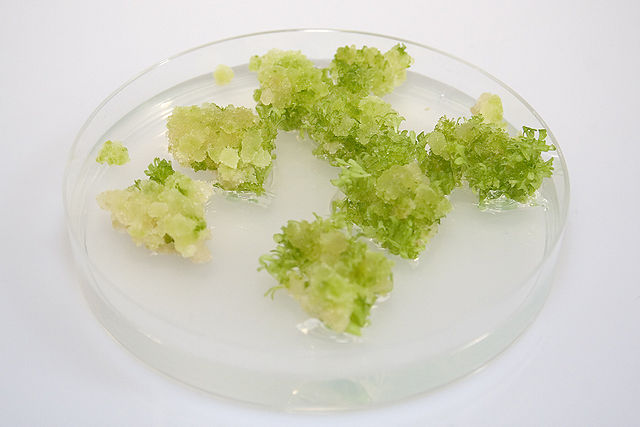
Figure \(\PageIndex{g}\): Private plant cells are first genetically engineered withAgrobacterium. They then grow into calluses (blobs of undifferentiated establish cells) and are given hormones to induce root and shoot development. Considering all the cells in the constitute that eventually grows descended from a single genetically engineered cell, the entire plant is transgenic. Prototype by Igge (CC-Past-SA).
Examples of Genetically Modified Crops
Many genetically modified crops accept been approved in the U.South. and produce our foods. The kickoff genetically modified organism approved by the U.South. Food and Drug Assistants (FDA) in 1994 wasFlavr Savr™ tomatoes, which have a longer shelf life (delayed rotting) because a gene responsible for breaking down cells in inhibited. Flavr Savr tomatoes are genetically modified (because their DNA has been contradistinct) simply non trasgenic (considering they do not contain genes from another species). The Flavr Savr lycopersicon esculentum did not successfully stay in the market place because of problems maintaining and shipping the crop.Golden riceproduces β-carotene, a forerunner to vitamin A (figure \(\PageIndex{h}\); β-carotene is besides in high concentrations in carrots, sweet potatoes, and cantaloupe, giving them their orange colour.)Roundup Set® corn, cotton fiber, and soybeans are resistant to this common herbicide, making it easier to uniformly spray it in a field to kill the weeds without harming the crops (figure \(\PageIndex{i}\)).
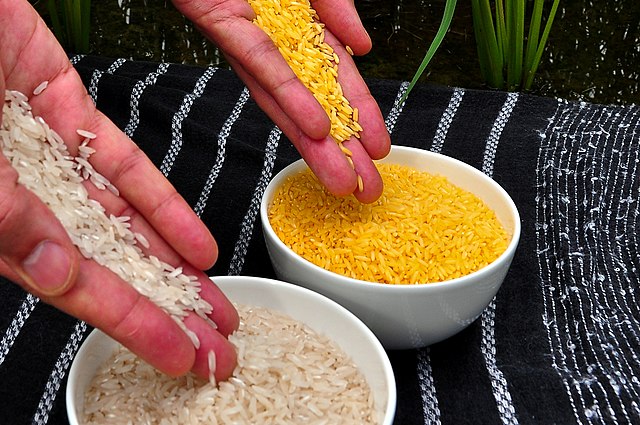
Figure \(\PageIndex{h}\): Golden rice has an orange-yellow color because it contains upwards to 35 μg β-carotene (a precursor to vitamin A) per gram of rice, which could prevent millions of cases of blindness worldwide. Epitome past International Rice Research Constitute (CC-BY).
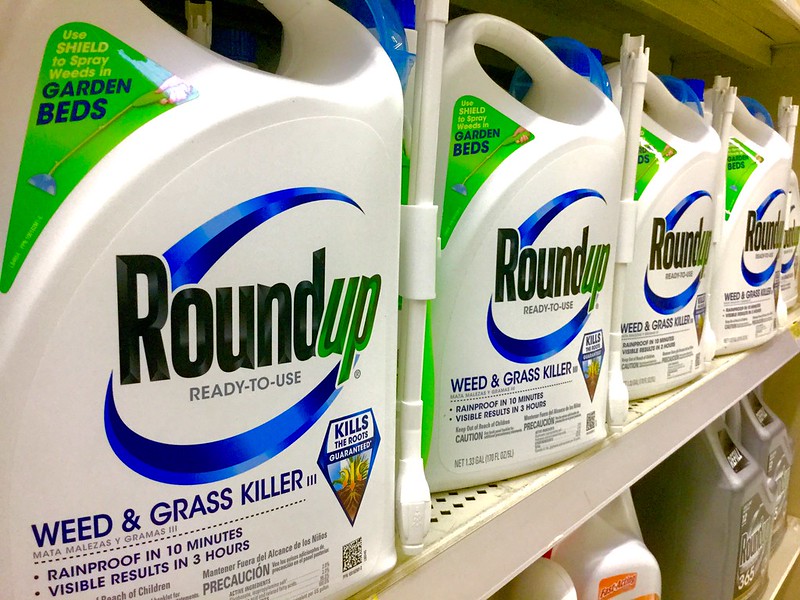
Figure \(\PageIndex{i}\): Roundup is a common herbicide. Roundup Prepare® plants are genetically modified to resist roundup, significant the herbicide does non kill them. This allows farmers to uniformly spray Roundup, killing weeds without harming the crops. Image by Mike Mozart (CC-Past).
Crops take besides been engineered to produce insecticides. Bacillus thuringiensis (Bt) is a bacterium that produces poly peptide crystals that are toxic to many insect species that feed on plants. Insects that take eaten Bt toxin stop feeding on the plants inside a few hours. Later on the toxin is activated in the intestines of the insects, death occurs within a couple of days. The gene to produceBt toxinhas been added to many crops including corn (figure \(\PageIndex{j}\)), potatoes, and cotton wool, providing plants with defense against insects.

Figure \(\PageIndex{j}\): Genetic engineering science to produce Bt corn. The cistron fromBacillus thuringiensisthat produces Bt toxin is removed and inserted into the corn institute. The Bt corn at present produces the insecticide (Bt toxin) and can defend itself against pests. Paradigm by FDA (public domain).
Genetically modified foods are widespread in the Us. For example, 94% of soy crops were genetically modified for herbicide resistance in 2020. Likewise, 8% of cotton and 10% of corn crops were modified for herbicide resistance in improver to the 83% of cotton fiber and 79% of corn crops that were genetically modified in multiple means.
Genetically modified animals take recently entered the marketplace also.AquaAdvantage® salmonare modified to grow more chop-chop and were approved in November of 2015. However, as of March 2021, they have still not been sold due to legal challenges. In 2020, the FDA approved GalSafe™ pigs for medicine and food production. These pigs lack a molecule on the outside of their cells that cause allergies in some people.
Advantages of Genetically Modified Crops
Advances in biotechnology may provide consumers with foods that are nutritionally-enriched, longer-lasting, or that contain lower levels of certain naturally occurring toxins present in some nutrient plants. For example, researchers are using biotechnology to endeavor to reduce saturated fats in cooking oils and reduce allergens in foods. Whether these benefits will reach the people who need them nigh remains to be seen. While cultivating gilt rice could address vitamin A deficiency in millions of people, information technology has not historically been accessible to these people considering it is patented and expensive. Similarly, genetically modified seeds could increase the income of impoverished farmers if they were available at low or no toll, but this is non always the instance.
Rainbow and SunUp papayas are a success story of how genetically modified crops tin benefit small farmers and the economic system in general. In the early 1990s, an emerging disease was destroying Hawaii's product of papaya and threatening to decimate the $xi-million industry (effigy \(\PageIndex{thousand}\)). Fortunately, a man named Dennis Gonsalves (figure \(\PageIndex{l}\)), who was raised on a carbohydrate plantation and then became a plant physiologist at Cornell University, would develop papaya plants genetically engineered to resist the deadly virus. By the terminate of the decade, the Hawaiian papaya industry and the livelihoods of many farmers were saved thank you to the free distribution of Dr. Gonsalves's seeds.

Figure \(\PageIndex{k}\): The symptoms of papaya ringspot virus are shown on the tree (a) and fruit (b). Paradigm by APS (public domain).

Figure \(\PageIndex{50}\): Dennis Gonsalves genetically engineered papayas to resist the ringspot virus. Paradigm by ARS USDA (public domain).
The result of genetically modified crops on the environment depends on the specific genetic modification and which agricultural practices it promotes. For case, Bt crops produce their own insecticides such that external application of these chemicals is unnecessary, reducing the negative impacts of industrial agronomics. Ongoing research is exploring whether crops can exist engineered to prepare nitrogen in the atmosphere (as some leaner do) rather than relying on ammonium, nitrites, and nitrates in the soil. If these crops were successfully engineered, they could reduce constructed fertilizer application and minimize food runoff that leads to eutrophication.
Genetically modified crops may have the potential to conserve natural resources, enable animals to more effectively use nutrients present in feed, and assist meet the increasing globe food and land demands. In practice, withal, countries that utilize genetically modified crops compared to those that practise not only enjoy a slight (or nonexistent) increase in yield.
Disadvantages of Genetically Modified Crops
Social Concerns
Intellectual belongings rights are i of the important factors in the current debate on genetically modified crops. Genetically modified crops tin can be patented by agribusinesses, which can lead to them controlling and potentially exploiting agronomical markets. Some charge companies, such as Monsanto, of allegedly decision-making seed product and pricing, much to the detriment of farmers (figure \(\PageIndex{m}\)).
Effigy \(\PageIndex{m}\): Protesters in Washington D.C. oppose genetically modified organisms and Monsanto specifically. Image cropped from Sarah Stierch (CC-BY).
Environmental Concerns
Genetically modified crops present several environmental concerns. Monoculture farming already reduces biodiversity, and cultivating genetically modified crops, for which individual plants are quite like genetically, exacerbates this. The utilize of Roundup Ready® crops naturally encourages widespread herbicide use, which could unintentionally kill nearby native plants. This practice would as well increment herbicide residues on produce. While Bt crops are benign in the sense that they do not crave external insecticide application, but Bt toxin is spread in their pollen. An early study plant that Bt corn pollen may exist harmful to monarch caterpillars (figure \(\PageIndex{n}\)), just but at concentrations that are seldom reached in nature. Follow-upwards studies constitute that almost of Bt corn grown did not harm monarchs; all the same, the one strain of Bt corn did was consequently removed from the market place.
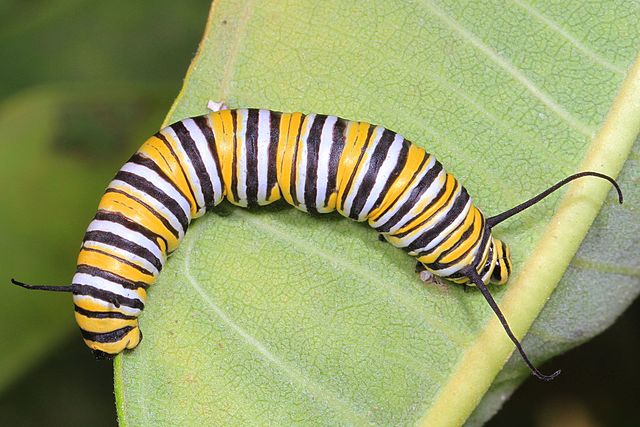
Effigy \(\PageIndex{n}\):An early study suggested that pollen containing Bt toxin can harm benign and native insects, like this monarch caterpillar. Nevertheless, without Bt crops, farmers are more than likely to spray insecticides, circulating more harmful chemicals than pollen from Bt crops does. Epitome by Judy Gallagher (CC-BY).
Through interbreeding, or hybridization, genetically modified crops might share their transgenes with wild relatives. This could affect the genetics of those wild relatives and accept unforeseen consequences on their populations and could even take implications for the larger ecosystem. For instance, if a gene engineered to confer herbicide resistance were to laissez passer from a genetically modified ingather to a wild relative, information technology might transform the wild species into a super weed – a species that could not be controlled by herbicide. Its rampant growth could so displace other wild species and the wild animals that depends on it, thus inflecting ecological harm.
Not only could escaped genes change weedy species, but they could also enter populations of native species. This could make some native species better competitors than they were previously, disrupting ecosystem dynamics. (They could potentially outcompete other native species with which they would otherwise coexist.)
While there is prove of genetic transfer between genetically modified crops and wild relatives, there is not withal evidence of ecological harm from that transfer. Conspicuously, connected monitoring, especially for newly-developed crops, is warranted.
The escape of genetically modified animals has potential to disrupt ecosystems every bit well. For example, if AquaAdvantage salmon were to escape into natural ecosystem, as farmed fish often do, they could outcompete native salmon, including endangered species. Their genetic modification, which facilitates rapid growth, could result in a competitive reward.
Wellness Concerns
In addition to environmental risks, some people are concerned about potential health risks of genetically modified crops because they experience that genetic modification alters the intrinsic properties, or essence, of an organism. As discussed to a higher place, even so, it is known that both traditional breeding practices and modernistic genetic engineering produce permanent genetic changes. Furthermore, selective breeding actually has a larger and more than unpredictable impact on a species'southward genetics because of its comparably crude nature.
To accost these concerns (and others), the U.s. National Academies of Sciences, Engineering, and Medicine (NASEM) published a comprehensive, 500-page report in 2022 that summarized the current scientific cognition regarding genetically modified crops. The written report, titled Genetically Engineered Crops: Experiences and Prospects, reviewed more 900 inquiry articles, in addition to public comments and expert testimony. NASEM's GE Crop Study found "no substantiated evidence of a difference in risks to human being health between current commercially available genetically engineered (GE) crops and conventionally bred crops, nor did it find conclusive cause-and-effect evidence of environmental problems from the GE crops." Additionally, the United nations's Nutrient and Agriculture Organization has concluded that risks to human and animal wellness from the use of GMOs are negligible. The scientific consensus on genetically modified crops is quite articulate: they are safe for human consumption.
The potential of genetically modified crops to be allergenic is one of the potential adverse wellness effects, and information technology should continue to be studied, particularly because some scientific evidence indicates that animals fed genetically modified crops have been harmed. NASEM'southward GE Crop Report ended that when developing new crops, it is the product that should be studied for potential health and environmental risks, not the process that achieved that product. What this means is, because both traditional breeding practices and modern genetic engineering science produce new traits through genetic modification, they both nowadays potential risks. Thus, for the safety of the environment and human health, both should be adequately studied.
Are Genetically Modified Crops the Solution We Need?
Significant resources, both financial and intellectual, have been allocated to answering the question: are genetically modified crops safe for human consumption? Afterward many hundreds of scientific studies, the respond is aye. But a significant question still remains: are they necessary? Certainly, such every bit in instances like Hawaii's papaya, which were threatened with eradication due to an aggressive disease, genetic engineering was a quick and constructive solution that would have been extremely difficult, if not impossible, to solve using traditional breeding practices.
However, in many cases, the early on promises of genetically engineered crops – that they would improve nutritional quality of foods, confer disease resistance, and provide unparalleled advances in ingather yields – take largely failed to come to fruition. NASEM's GE Crop Written report states that while genetically modified crops accept resulted in the reduction of agronomical loss from pests, reduced pesticide use, and reduced rates of injury from insecticides for subcontract workers, they accept not increased the rate at which ingather yields are advancing when compared to non-GE crops. Additionally, while there are some notable exceptions like golden rice or virus-resistant papayas, very few genetically engineered crops accept been produced to increase nutritional capacity or to forbid plant disease that tin can devastate a farmer's income and reduce food security. The vast majority of genetically modified crops are developed for just ii purposes: to introduce herbicide resistance or pest resistance. Genetically modified crops are full-bodied in developed countries, and their availability in developing countries, where they are perchance most needed, is limited (figure \(\PageIndex{o}\)).

Figure \(\PageIndex{o}\):Global surface area of genetically modified crops in millions of hectares 1996–2015. Overall, the hectares of genetically modified crops has increased, and in 2011, developing countries surpassed industrial countries. Past 2015, out of the 28 countries that grew biotech crops, twenty were developing, and simply eight were developed countries. Latin American, African, and Asian farmers together grew 97.1 million hectares (54%) of the global 179.seven meg biotech hectares, whereas industrial countries but planted 83 million hectares or 46%. Image and explanation (modified) from Taheri, F., Azadi, H., & D'Haese, M. (2017). A World without Hunger: Organic or GM Crops? Sustainability , ix (4), 580. doi:10.3390/su9040580. (CC-By)
Source: https://bio.libretexts.org/Bookshelves/Ecology/Environmental_Science/04:_Humans_and_the_Environment/4.03:_Agriculture/4.3.03:_Selective_Breeding_and_Genetic_Engineering

0 Response to "How Can Humans Selectively Breed a Vegetable to Produce a More Desirable Crop?"
Post a Comment